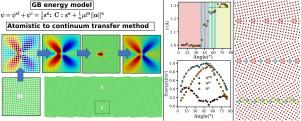当前位置:
X-MOL 学术
›
Acta Mater.
›
论文详情
Our official English website, www.x-mol.net, welcomes your
feedback! (Note: you will need to create a separate account there.)
On the atomistic origin of internal length scale in strain-gradient plasticity models: The case of grain boundary structures and energies
Acta Materialia ( IF 8.3 ) Pub Date : 2024-11-17 , DOI: 10.1016/j.actamat.2024.120555 Houssam Kharouji, Vincent Taupin, Julien Guénolé
Acta Materialia ( IF 8.3 ) Pub Date : 2024-11-17 , DOI: 10.1016/j.actamat.2024.120555 Houssam Kharouji, Vincent Taupin, Julien Guénolé

|
The mechanical behavior of polycrystalline materials is controlled by microstructural size effects such as grain size or precipitate size. Various models of strain gradient plasticity have been proposed to capture such size effects, many of which have incorporated geometrically-necessary dislocation (GND) densities to introduce characteristic internal lengths. Recent developments have focused on models that incorporate a GND density into the internal energy functional. In such models, one needs to physically justify the functional form chosen and quantify the inherent internal length parameter. Our present study aims at probing relevant forms and internal length values in the case of grain boundary (GB) atomistic structures and core energies. We use an atomistic-to-continuum crossover approach that predicts an atomistic structure dependent GB energy by molecular static simulations, which is then recovered at the continuum-level by using a strain gradient, atomistically informed, field dislocation mechanics fast Fourier transform model. This allows (i) delineating the atomistic structure of GBs using an equivalent Nye GND density, and (ii) capturing the associated continuous elastic fields in the GB core area. We probe (i) a generalized non-quadratic GND density dependent energy functional to account for the core energy of defects, and (ii) elucidate the contributions of core versus elastic energy to the overall GB excess energy. We investigate and discuss the possible relevant choices for the energy functional form, as well as the physical origin of the inherent internal length parameter and its dependence to the types of grain boundaries, atomistic structures, and spatial resolution.
中文翻译:

应变梯度塑性模型中内部长度尺度的原子起源:晶界结构和能量的情况
多晶材料的机械行为受微观结构尺寸效应(如晶粒尺寸或沉淀物尺寸)的控制。已经提出了各种应变梯度塑性模型来捕获这种尺寸效应,其中许多模型都结合了几何必要的位错 (GND) 密度来引入特征内部长度。最近的发展集中在将 GND 密度纳入内部能量泛函的模型上。在这样的模型中,需要物理证明所选择的功能形式是合理的,并量化固有的内部长度参数。我们本研究旨在探索晶界 (GB) 原子结构和核心能量情况下的相关形式和内部长度值。我们使用原子到连续体交叉方法,通过分子静态模拟预测依赖于原子结构的 GB 能量,然后使用应变梯度、原子知情的场位错力学快速傅里叶变换模型在连续体水平上恢复。这允许 (i) 使用等效的 Nye GND 密度描绘 GB 的原子结构,以及 (ii) 在 GB 核心区域中捕获相关的连续弹性场。我们探测了 (i) 广义非二次 GND 密度依赖能量泛函,以解释缺陷的核心能量,以及 (ii) 阐明核心能量与弹性能对整体 GB 过剩能量的贡献。我们调查并讨论了能量泛能形式的可能相关选择,以及固有内部长度参数的物理起源及其对晶界类型、原子结构和空间分辨率的依赖性。
更新日期:2024-11-17
中文翻译:

应变梯度塑性模型中内部长度尺度的原子起源:晶界结构和能量的情况
多晶材料的机械行为受微观结构尺寸效应(如晶粒尺寸或沉淀物尺寸)的控制。已经提出了各种应变梯度塑性模型来捕获这种尺寸效应,其中许多模型都结合了几何必要的位错 (GND) 密度来引入特征内部长度。最近的发展集中在将 GND 密度纳入内部能量泛函的模型上。在这样的模型中,需要物理证明所选择的功能形式是合理的,并量化固有的内部长度参数。我们本研究旨在探索晶界 (GB) 原子结构和核心能量情况下的相关形式和内部长度值。我们使用原子到连续体交叉方法,通过分子静态模拟预测依赖于原子结构的 GB 能量,然后使用应变梯度、原子知情的场位错力学快速傅里叶变换模型在连续体水平上恢复。这允许 (i) 使用等效的 Nye GND 密度描绘 GB 的原子结构,以及 (ii) 在 GB 核心区域中捕获相关的连续弹性场。我们探测了 (i) 广义非二次 GND 密度依赖能量泛函,以解释缺陷的核心能量,以及 (ii) 阐明核心能量与弹性能对整体 GB 过剩能量的贡献。我们调查并讨论了能量泛能形式的可能相关选择,以及固有内部长度参数的物理起源及其对晶界类型、原子结构和空间分辨率的依赖性。


















































 京公网安备 11010802027423号
京公网安备 11010802027423号